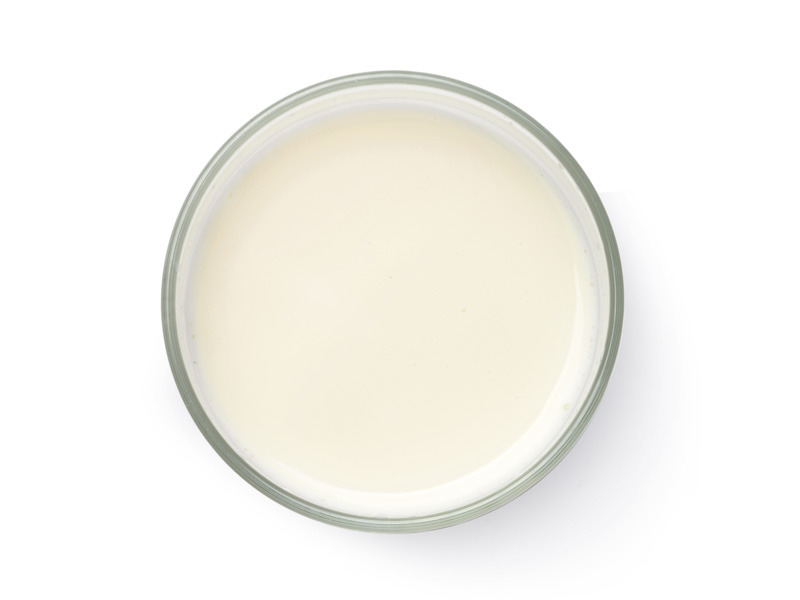Dispersible polymer powder

Exclusive Team Member
EXPERT MEMBERSSatisfied Clients
TRUSTED PEOPLEOur Local & Global Stores
GLOBAL PARTNERMonthly production capacity
Ton
IPCC is the most influential coatings exhibition in the Middle East and Central Asia, and be held in Tehran from December 3rd to 6th, 2025. This unprecedented four-day event attracted nearly 500 exhibitors from around the world and over 30,000 industry professionals. As one of the most professional Polyvinyl Alcohol(PVA), Vinyl Acetate–ethylene Copolymer Emulsion(VAE Emulsion), and Chloroprene Rubber(CR) suppliers in China, Jiangsu ElephChem was invited to participate in this exhibition. ElephChem's booth showcased the company's latest achievements in industrial coatings, powder coatings, resins, and new surface treatment materials, with a focus on promoting its environmentally friendly water-based coatings and high-value-added functional coating solutions. Highlights and Response During the Exhibition Product and Technology Showcase Attracts Attention — ElephChem's exhibits covered industrial coatings, powder coatings, resins, and a variety of coating systems suitable for construction, automotive, and industrial equipment, meeting the needs of the Middle East and Iranian markets for weather-resistant, corrosion-resistant, and high-performance coatings. Many visitors expressed strong interest in its environmentally friendly and high-performance formulations. High-Quality B2B Negotiations — Leveraging the IPCC platform, ElephChem held in-depth discussions with dozens of distributors, coating equipment suppliers, and potential end-users from Iran and elsewhere, reaching preliminary agreements on agency partnerships, technology supply, and order collaborations. Market Potential and Strategic Value Widely Recognized — Exhibitors and industry peers expressed their anticipation for ElephChem's ability to bring advanced Chinese coating technology to the Iranian and even Middle Eastern markets. Many potential clients requested samples and product information on-site, hoping for further testing and cooperation. By participating in IPCC 2025, ElephChem successfully showcased its brand to the Iranian and Middle Eastern coating markets for the first time, laying the foundation for future business development in the region. This exhibition not only brought the company orders and potential cooperation opportunities but also provided valuable information on local market demands, regulations and standards, customer preferences, and the competitive landscape. Website: www.elephchem.com Whatsapp: (+)86 13851435272 E-mail: admin@elephchem.com
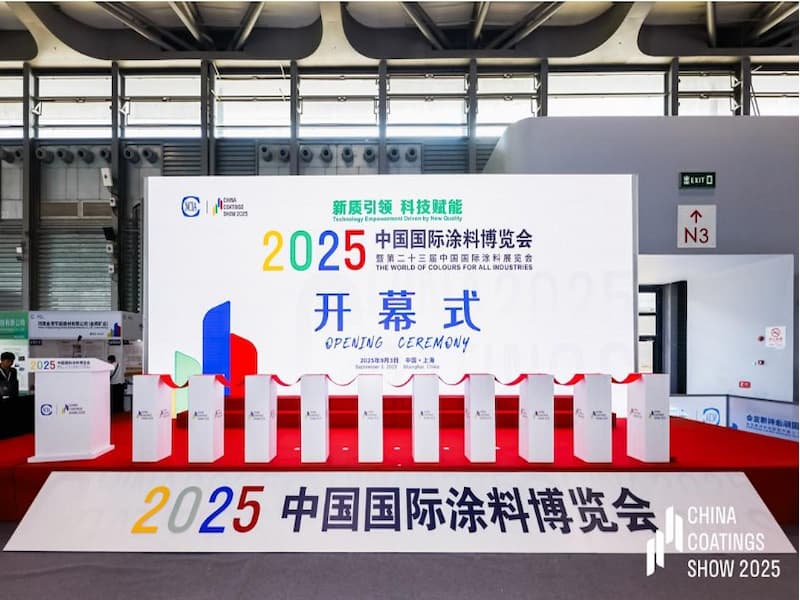
The three-day "China Coatings Show 2025" concluded successfully in Shanghai. JiangSu ElephChem Holding Limited, a key player in the industry, achieved great success at the exhibition, showcasing its latest innovative products and sustainable solutions. ♦ Innovation Leads the Future: Showcasing Cutting-Edge Technologies and Solutions At this exhibition, JiangSu ElephChem Holding Limited focused on core trends for the future of the coatings industry: high performance, environmental friendliness, and digital applications. The company's booth attracted professional visitors, partners, and industry experts from around the world. Highlights included: Next-Generation Environmentally Friendly Solvents and Additives: Several low-odor, high-efficiency, and environmentally friendly products were launched to meet stringent VOC (volatile organic compound) emission reduction requirements, attracting widespread attention from domestic and international customers. Functional Polymer Materials: A focus was placed on showcasing high-end resins and additives for water-based coatings, high-durability industrial coatings, and specialty adhesives. Supply Chain Optimization Services: Emphasizing the company's global advantages in raw material supply, quality control, and logistics management, providing customers with stable and reliable one-stop solutions. ♦ In-depth Cooperation: Exploring New Industry Opportunities Together During the exhibition, the senior management team of JiangSu ElephChem Holding Limited actively engaged in in-depth discussions with customers and partners, exploring current market challenges and opportunities. This participation in the exhibition was not only a successful showcase of the company's products but also a reflection of the company's commitment to promoting the upgrading of the global coatings industry chain and fulfilling its corporate social responsibility. With the successful conclusion of this exhibition, JiangSu ElephChem Holding Limited looks forward to growing together with all the partners who established connections at the exhibition, continuing to provide world-class products and services to the coatings and related industries, and jointly painting a more sustainable future. Website: www.elephchem.com Whatsapp: (+)86 13851435272 E-mail: admin@elephchem.com ElephChem Holding Limited, professional market expert in Polyvinyl Alcohol(PVA) and Vinyl Acetate–ethylene Copolymer Emulsion(VAE) with strong recognition and excellent plant facilities of international standards.
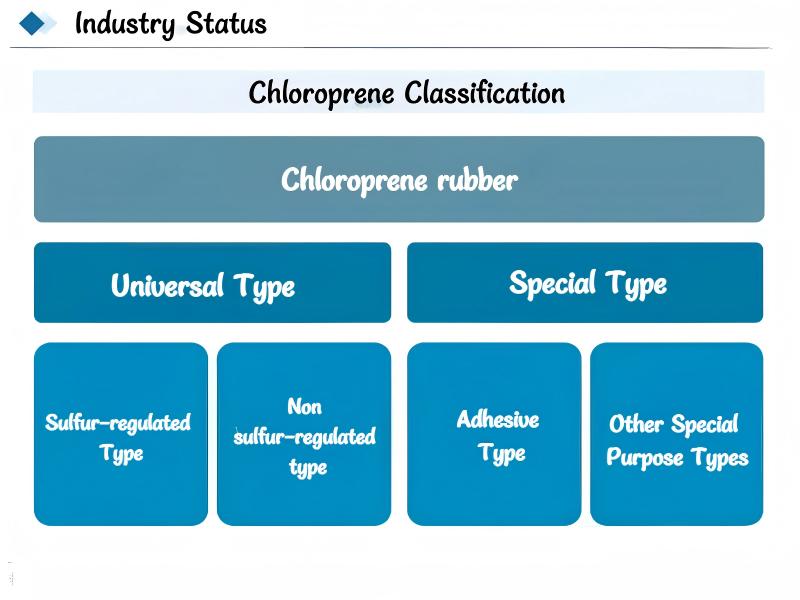
1. Industry Overview Chloroprene Rubber (Neoprene Latex) is a synthetic rubber produced by emulsion polymerization of 2-chloro-1,3-butadiene.Chloroprene rubber has chlorine atoms in its molecular structure, which gives it good resistance to oils, weather, flames, and chemicals. It also has acceptable mechanical properties and elasticity. DuPont first made CR in 1931 under the name Neoprene, making it one of the first synthetic rubbers to be produced on a large scale. CR comes in two types: general-purpose and specialty, depending on its properties and uses. 2. Industry Chain The chloroprene rubber industry depends on a few key components at the start of its process. These are mainly raw materials and the machines needed for production. Raw materials consist of things like chloroprene itself, along with catalysts, solvents, emulsifiers, initiators, antioxidants, and regulators. On the equipment side, you'll find polymerization reactors, emulsification equipment, degassing devices, packaging machines, waste gas treatment devices, wastewater treatment systems, and safety monitoring systems. Chloroprene rubber finds its main uses in products like transmission belts, sealing strips, hoses, rubber sheets, waterproof membranes, adhesives, anti-corrosion coatings, cable sheaths, and insulation materials. 3.Industry Status China is a major producer and consumer of chloroprene rubber. This industry has seen good growth because of rising demand from the car, construction, electronics, and medical device fields. From January to May 2025, China made 27,200 tons of chloroprene rubber, up 15.80% from last year. The consumption of this material reached 21,700 tons, which is a 30.67% increase compared to the previous year. In June 2025, the operating rate for China's chloroprene rubber plants was 38.74%. This is down 31.63% from May, but up 16.45% from June of the previous year. The lower rate is typical for June because demand is usually low then. Big industries that use the rubber, like car makers and construction, often adjust their production during this time. Specifically, the car industry saw slower demand for parts due to talk of fewer payments for new energy cars and car companies cutting prices. The construction business in southern China also used less waterproofing material because of the rainy season, which meant less neoprene rubber was needed. It didn't help that there were more global trade issues and that the EU started looking into whether China was selling rubber products too cheaply. This lowered the number of export orders and made demand even weaker. Between January and May 2025, China imported 6,900 tons of neoprene rubber, up 12.66% from the same period last year. The value of these imports reached 237 million yuan, an increase of 12.05% year-over-year. Over the same period, China's neoprene rubber exports totaled 10,400 tons, a 10.36% decrease from the previous year. The export value was 283 million yuan, down 15.24% compared to last year. Overall, my country's dependence on imported neoprene rubber is gradually decreasing, with imports increasing from 19,600 tons in 2020 to 17,300 tons in 2024, while exports are expected to increase from 11,000 tons in 2020 to 26,400 tons in 2024. 4. Industry Development Trends 4.1 Accelerated Development of High-End and Specialized Products Leading enterprises, by introducing DuPont's continuous polymerization reactor process and combining it with their independently developed neoprene latex flash degassing technology, have successfully developed high-end models such as Chloroprene Rubber DCR1141 and Chloroprene Rubber DCR2133. These products boast a 30% improvement in heat resistance and internationally leading chemical corrosion resistance. Leveraging 77 years of technological accumulation, they have built the world's first specialized neoprene rubber production line. The expansion of downstream applications further drives the high-end development process. The need for neoprene rubber is growing in new energy vehicles as it is used to seal and insulate battery packs. Also, the construction of 5G communication base stations has increased the usage of high-temperature neoprene rubber in electronic component packaging two-fold. 4.2 Green Manufacturing Becomes a Core Strategy Environmental policies are forcing the industry to accelerate its green transformation. The industry is increasing its R&D efforts in high-performance, environmentally friendly neoprene rubber products. 4.3 Deepening Global Layout Chinese neoprene rubber companies are shifting from scale expansion to value creation. Leading enterprises have obtained EU REACH certification and established R&D centers in Germany, resulting in a surge in sales in the European market. International competitive strategies are showing differentiation. The European and American markets focus on technological barriers, seizing high-end markets through customized products (such as medical-grade neoprene). At the policy level, the Belt and Road Initiative has boosted demand in participating countries, significantly enhancing the industry's international influence. Website: www.elephchem.com Whatsapp: (+)86 13851435272 E-mail: admin@elephchem.com JiangSu ElephChem Holding Limited, professional market expert in Chloroprene Rubber and Polyvinyl Alcohol(PVA) with strong recognition and excellent plant facilities of international standards.
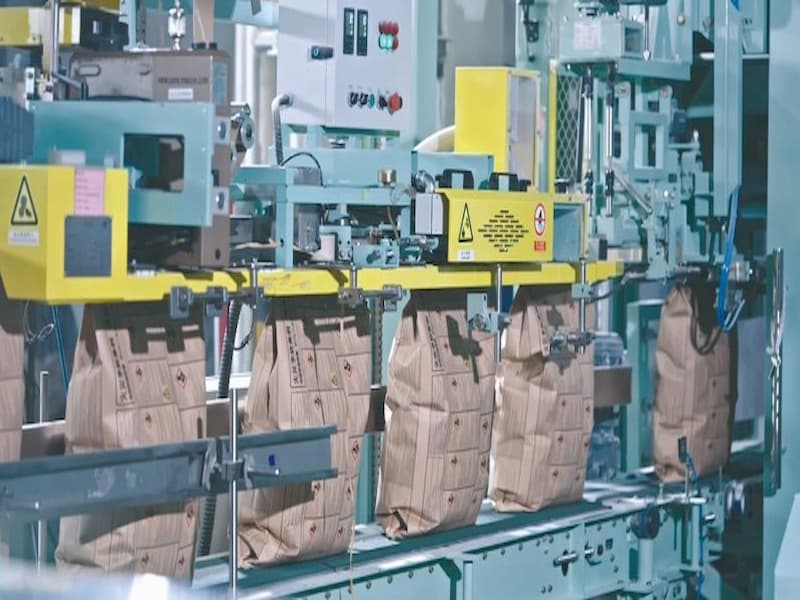
As a leading company specializing in polyvinyl alcohol (PVA) and related high-performance chemicals, JiangSu ElephChem Holding Limited is actively making "Chemistry for a Cleaner, Greener, and More Prosperous Future" a reality. The company's sustainability strategy clearly identifies "circular economy, rational resource management, and collaborative co-creation" as core principles and outlines its "Zero Harm, Zero Waste" operational commitment. Environmental Highlights Strong Degradability and Solubility PVA, a polymer with greater environmental potential than traditional plastics, is water-soluble and biodegradable under certain conditions. According to industry analysts, PVA film materials are replacing non-degradable plastic packaging, helping to reduce plastic waste. Resource Management from Raw Materials to Production JiangSu ElephChem Holding Limited emphasizes resource conservation and waste minimization in its raw material procurement, production process design, and waste disposal processes. The company's website states that its product portfolio meets or exceeds most green certification standards. Promoting a Circular Economy Under the concept of a "circular economy," the company is committed to "recycling and reducing waste." It not only explores sustainable solutions within its own production processes but also collaborates with upstream and downstream stakeholders in the industry chain to promote the application of sustainable solutions. Advantages of PVA Products in Sustainable Applications In the packaging industry, PVA film can be used for water-soluble packaging, biodegradable packaging bags, and disposable product packaging, helping brands reduce their use of traditional plastics. In traditional industries such as textiles, building materials, and paper adhesives, PVA applications are also being optimized to improve production efficiency while reducing environmental impact. Market research shows that the PVA film market is growing at a compound annual growth rate of approximately 5.7%, primarily driven by rising demand for green packaging. The company will continue to increase its R&D investment in environmentally friendly PVA products and new materials (such as water-soluble films and modified PVA fiber) to meet market demand for "high-performance, low-environmental-impact" materials. It also plans to strengthen collaboration with customers, research institutions, and industry partners to explore the application of PVA in emerging fields such as sustainable packaging, biomedicine, and agricultural films. In this way, JiangSu ElephChem Holding Limited is not only transforming its products to be environmentally friendly, but also acting as a green driving force within the industry chain. Amid the global push for carbon neutrality and a circular economy, JiangSu ElephChem Holding Limited is actively assuming corporate responsibility, leveraging its expertise in PVA and related materials and its environmentally friendly strategy. Going forward, the company strives to bring greener, safer, and more efficient material solutions to a wider range of applications. Website: www.elephchem.com Whatsapp: (+)86 13851435272 E-mail: admin@elephchem.com JiangSu ElephChem Holding Limited, professional market expert in Polyvinyl Butyral Resin (PVB) and Polyvinyl Alcohol(PVA) with strong recognition and excellent plant facilities of international standards.

1. Industry Overview PVA film is a green, environmentally friendly, functional material made from polyvinyl alcohol (PVA) with modifiers and other additives, processed through a specialized process. It features excellent density, high crystallinity, and strong adhesion. The film produced is flexible, smooth, resists oil and solvents, resists scrapes, and blocks gas well. Furthermore, PVA film is biodegradable by bacteria and enzymes, making it a biodegradable polymer material with good environmental compatibility and pollution-free properties. 2. Industry Development History The development of China's PVA film industry has primarily progressed through five phases. The early exploration phase, from the 1950s to the 1970s, saw the initial application of optical PVA film in areas such as projectors and televisions in the 1950s. However, the overall scale of application was small, and the technology was in its early stages of development. During this period, China's chemical industry had a relatively weak foundation, with PVA film production technology primarily dependent on imports. Domestic research and application of this technology was in its infancy. From the 1980s to the 1990s, China experienced a period of rapid development. With the rise of liquid crystal display technology in the 1980s, optical PVA film gained widespread application, leading to rapid growth in market demand. China began introducing advanced foreign technology and equipment, attempting to domesticate PVA film production. While some companies ventured into this field, the overall technological level still lagged significantly behind that of foreign countries. From the 1990s to the early 21st century, China experienced a period of steady growth. In the early 21st century, the optical PVA film industry gradually matured, with continuous technological advancements, significant improvements in product performance, and a further expansion of its application areas. Through technological accumulation and independent innovation, some domestic companies gradually mastered the core production technology for PVA film, continuously improving product quality and production scale, and began to capture a significant share of the domestic market. From the early 21st century to 2020, China experienced a period of diversified development. In recent years, the application areas of optical PVA film have continued to expand. Beyond traditional display applications, it has also been widely used in mobile phone screens, e-book readers, touch screens, polarizers, and other applications, resulting in continued market demand. Domestic companies are increasing their R&D investment and continuously exploring new production processes and material formulations, driving the development of PVA film products towards high performance, high quality, and customization. During the rapid growth period since 2020, with the rapid advancement of emerging technologies such as flexible displays, photovoltaic cells, and fuel cells, the application of PVA film in these fields has continued to expand, driving the industry towards high-end, intelligent, and green development. The Chinese government has introduced a series of policies to support the development of the new materials industry, including R&D investment and tax incentives, providing strong support for technological innovation and industrial upgrading in the PVA film industry. 3. Industry Status In 2023, the market size of China's PVA film industry is expected to reach 2.22 billion yuan, an increase of 18.09% year-on-year. The sales figure is the highest in five years, showing that environmentally friendly materials are doing well, even though the traditional plastic film market is slow. Because of good policies and tech improvements, more areas are using PVA film, like electronics, IT, energy, and health. In the electronics and information technology sector, with the development of technologies such as 5G and the Internet of Things, demand for high-performance, thin, and transparent PVA film is increasing. In the new energy sector, PVA film, as a lithium battery separator material, can improve battery safety, energy density, and cycle life. Furthermore, with growing environmental awareness, PVA film's application in biodegradable packaging, biomedicine, and other fields is also increasing. This diversified market demand provides broad growth opportunities for the PVA film industry, driving the industry's transition from a "substitute" for traditional plastic films to a "mainstream material" across various fields. Website: www.elephchem.com Whatsapp: (+)86 13851435272 E-mail: admin@elephchem.com JiangSu ElephChem Holding Limited, professional market expert in PVA film and Polyvinyl Alcohol(PVA) with strong recognition and excellent plant facilities of international standards.
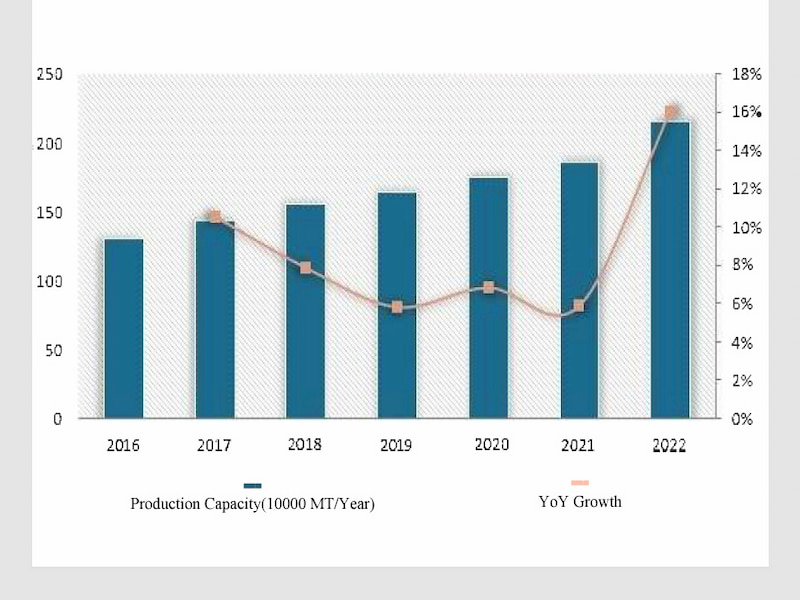
1. Phenolic Resin Overview Phenolic resin is a general term for resinous polymers formed by the condensation of phenol and aldehyde in the presence of an acidic or alkaline catalyst. It typically refers to resins obtained by the condensation of phenol or its homologues (such as cresol and xylenol) with formaldehyde. Phenolic resins offer excellent heat resistance, flame resistance, water resistance, and insulation properties. They are widely used in a wide range of applications, including phenolic molding compounds, woodworking and laminates, abrasive and friction materials, and fire-resistant and thermal insulation materials. 2. Phenolic Resin Production Capacity and Output Steadily Rising In recent years, driven by downstream demand and relevant policies, my country's phenolic resin industry has developed relatively steadily, with both production capacity and output showing a steady upward trend. Data shows that production capacity, primarily in East China and Central China, will increase from 1.3 million tons in 2016 to 2.1524 million tons in 2022. Production will also increase from 1.036 million tons in 2016 to 1.535 million tons in 2022. Currently, my country's phenolic resin industry still faces a phenomenon of "overcapacity at the low end and insufficient supply of high-end products," leaving significant room for domestic production of high-end products. 3. Phenolic molding compounds are the largest downstream demand segment for phenolic resins Based on their purity, phenolic resins can be divided into two categories: electronic grade phenolic resin and industrial-grade phenolic resins. Industrial-grade phenolic resins are primarily used in phenolic molding compounds, wood processing and laminates, abrasive and friction materials, and refractory materials. End-use applications include automotive, construction, metallurgy, and rail transportation. Electronic-grade phenolic resins are high-performance, high-value-added phenolic resins, primarily used in chip photoresists, electronic packaging, and copper-clad laminates. End-use applications include semiconductors, aerospace, and consumer electronics. Among them, phenolic molding compounds, grinding and friction materials, and wood processing and laminates are the three downstream application areas of phenolic resin in my country. Their market shares have remained relatively stable in recent years, reaching 21.94%, 20.17%, and 20.01% in 2021, respectively. In recent years, my country's downstream phenolic resin industry has developed well overall, with demand for phenolic resin steadily increasing, from 1.0423 million tons in 2016 to 1.5423 million tons in 2021. It is worth noting that due to the high technical barriers to electronic-grade phenolic resin, only a few companies in China can currently produce it. Supply currently cannot meet domestic market demand, and imports are needed to supplement it. 4. The import value and average import price of phenolic resin have consistently exceeded the export value and average export price Data shows that in recent years, my country has imported over 80,000 tons of phenolic resin annually, primarily high-end phenolic resin, reaching 86,000 tons in 2023, a slight year-on-year increase of 0.94%. Exports have remained above 90,000 tons, reaching 125,100 tons in 2023, an 18.69% year-on-year increase. Due to the high added value of high-end phenolic resins, my country's import volume and average import price of phenolic resins have always been higher than its export volume and average export price. Data shows that since 2021, its import volume has declined year by year, but its export volume has shown an annual growth trend, reaching 2.045 billion yuan and 1.542 billion yuan in 2023, respectively, a year-on-year decrease of 7.76% and an increase of 10.94%, respectively. With the decline in import volume of phenolic resins and the increase in export volume, its trade deficit has shown a shrinking trend since 2021, falling to 503 million yuan in 2023. Website: www.elephchem.com Whatsapp: (+)86 13851435272 E-mail: admin@elephchem.com JiangSu ElephChem Holding Limited, professional market expert in Phenolic resin and Polyvinyl Alcohol(PVA) with strong recognition and excellent plant facilities of international standards.
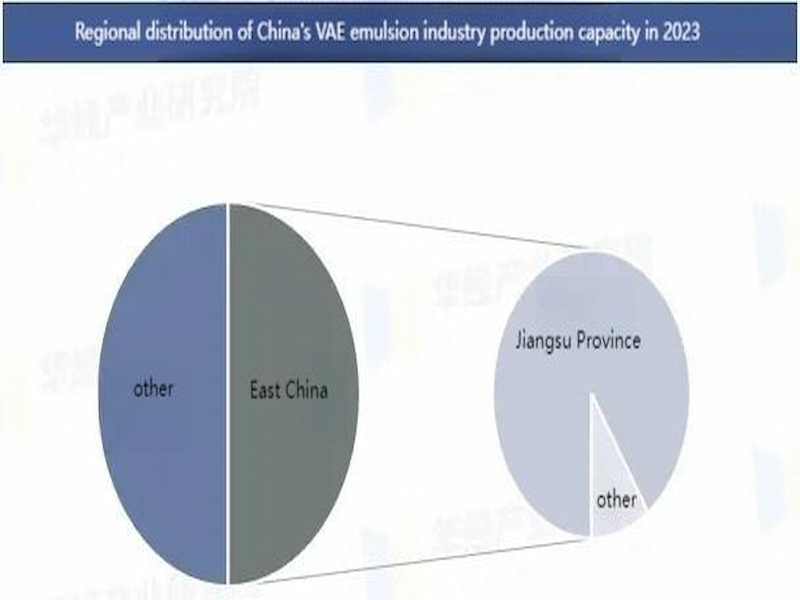
Changes in China's VAE emulsion production capacity are largely due to new construction and expansion projects in the industry. For example, the launch of a 20,000-ton annual VAE commercial emulsion expansion project in Jiangsu and Celanese's announcement to expand emulsion production capacity in Nanjing, China, have been significant. China is a key producer of VAE emulsions around the world, supported by many producers and production lines. Recently, the total production capacity for VAE emulsions has grown, due to increased market needs and better technology. Generally, China's VAE emulsion industry uses its capacity well, especially in areas that need a lot of adhesives and exterior building insulation. In these fields, production lines often run at their maximum. In 2023, East China, especially Jiangsu and Anhui, became the country's top area for making VAE emulsion. They made 620,000 tons a year, which is over half (56.88%) of all of China's production. Jiangsu did the most, producing 560,000 tons each year, accounting for 51.38% of the country’s total. China is a big maker and seller of VAE emulsions, and its sales to other countries have been going up. They mostly sell to Southeast Asia, Europe, and North America. Because they don't cost too much and are good quality, Chinese VAE emulsions are becoming important in the world market. Chinese companies are getting better at research, so they can now make many kinds of strong, special VAE emulsions, which means they don't need to buy as much from other countries. The better quality of VAE emulsions made in China means they can do many things, so China bought way less from other countries in 2021. As the industry gets better, they sell more and more to other countries each year. China's VAE emulsion import market is highly concentrated. Demand is growing and supply chain stability is gradually increasing. In 2023, Taiwan was the largest source of VAE emulsion imports, with imports reaching 27,699.13 tons, accounting for 47.06% of total imports, a year-on-year increase of approximately 35.54%. Singapore was second, with imports reaching 26,329.13 tons, accounting for 44.74% of total imports, a year-on-year increase of approximately 18.47%. Looking at the apparent consumption of China's VAE emulsion industry, from 2016 to 2021, the industry showed steady growth, driven by downstream demand. In 2022, due to a significant decline in production and imports, apparent demand fluctuated, falling from 791,600 tons in 2021 to 661,700 tons, a year-on-year decrease of 16.41%. Although apparent consumption rebounded in 2023, overall volatility remained significant. The self-sufficiency rate went up in 2022 and 2023, but consumption seemed to drop in 2022. Experts believe that this difference between production and demand changes could cause too much or too little inventory, which would change how supply and demand work in the market. This article is excerpted from "Analysis of the Current Development Status of China's VAE Emulsion Industry in 2023: The Launch of Jiangsu's 20,000-Ton Annual VAE Commercial Emulsion Expansion Project Will Drive Further Capacity Expansion in the Industry." Based on market share by production capacity, the competitive landscape in China's VAE emulsion industry is relatively concentrated. Wacker Chemie (China) Co., Ltd. holds the largest market share, at 18.35%. The remaining shares are similar for the remaining companies. The remaining 15.59% of the market share is held by other companies. This indicates that the market is primarily dominated by a few large companies, but there is also some market fragmentation, with other companies collectively sharing approximately one-sixth of the market share. Wanwei High-Tech Materials Co., Ltd. is a company primarily engaged in the research, development, production, and sales of new chemical materials. The VAE emulsion sector is a core part of the company's business. Its VAE emulsion products serve many purposes, mainly in adhesives, coatings, building materials, and textiles. Wanwei High-Tech has good production methods and tools, so it can make quality VAE emulsions that fit different customer needs. In 2023, the company made about 475 million yuan in revenue from VAE emulsions. Website: www.elephchem.com Whatsapp: (+)86 13851435272 E-mail: admin@elephchem.com JiangSu ElephChem Holding Limited, professional market expert in VAE Emulsion and Polyvinyl Alcohol(PVA) with strong recognition and excellent plant facilities of international standards.
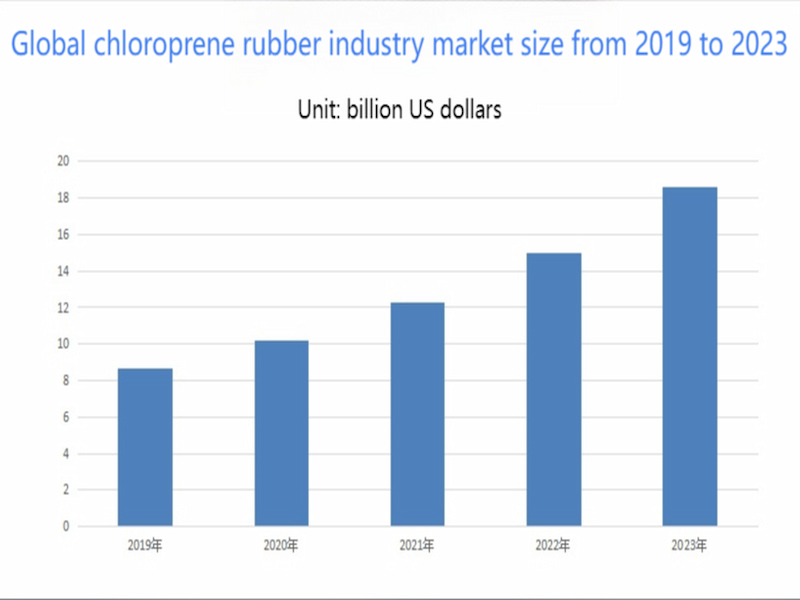
Chloroprene is a special synthetic rubber suitable for manufacturing tire liners, medical devices, seals and other fields. Competition in the chloroprene rubber market is also intensifying, and green environmental protection has become the mainstream development direction of chloroprene rubber. 1.Analysis of the chloroprene rubber industry The global chloroprene rubber (Neoprene latex) market size is US$2.09 billion in 2024, and is expected to reach US$2.44 billion by 2030, an increase of US$350 million. This is mainly driven by demand from the construction and automotive industries, especially the significant growth in demand in the Asia-Pacific region. China is one of the world's largest producers and consumers of chloroprene rubber. With the continuous development of domestic industries such as automobiles, electronics, and construction, the market demand for chloroprene rubber will continue to grow. In recent years, the demand for chloroprene rubber in my country has been around 50,000 to 60,000 tons, and is expected to maintain a growth trend in the next few years. There is a certain market competition in the chloroprene rubber industry. Many domestic and foreign companies compete for market share through continuous innovation, improving product quality and reducing costs. While facing international competition, domestic companies are also actively seeking technological breakthroughs and market expansion. In the context of globalization, international cooperation in the chloroprene rubber industry is constantly strengthening. Domestic companies have introduced advanced technology and management experience through cooperation and exchanges with foreign companies to enhance their competitiveness. 2. Development trend of chloroprene rubber industry Chloroprene rubber industry analysis mentioned that the manufacturing process and technology of chloroprene rubber are constantly improving to improve its performance characteristics, such as improving heat resistance, chemical corrosion resistance, mechanical strength, etc. Develop new chloroprene rubber products to meet the higher requirements of material performance in different industries, such as in the fields of automobile tires, medical devices, food packaging, etc. Improve the environmental performance of chloroprene rubber, including reducing energy consumption in the production process, reducing the impact on the environment, and promoting its sustainable development. Explore the research and development and application of bio-based chloroprene rubber, reduce dependence on fossil energy, and reduce carbon footprint. Increase application research in emerging industries such as electric vehicles and new energy fields, as well as applications in special environments (such as high temperature, high pressure, and chemical corrosion environments). Expand the application of chloroprene rubber in industrial seals, hoses and anti-vibration materials to meet the needs of industrial automation and intelligent manufacturing. Strengthen cooperation and exchanges with the international market, improve product quality and competitiveness, and strive for more international market share. Customize product solutions according to the needs of different regions and markets to improve market adaptability and market share. In summary, the future of the chloroprene rubber industry looks promising with new tech breakthroughs, a push for eco-friendly practices, and more areas where it can be used. As the global economy grows and technology moves forward, chloroprene rubber remains a useful material with plenty of opportunities ahead. Website: www.elephchem.com Whatsapp: (+)86 13851435272 E-mail: admin@elephchem.com JiangSu ElephChem Holding Limited, professional market expert in Polyvinyl Butyral (PVB) and Polyvinyl Alcohol(PVA) with strong recognition and excellent plant facilities of international standards.
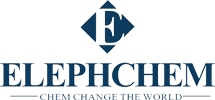
Signup our newsletter to get update information, promotion and insight.
